Solar eclipse of November 23, 1946
A partial solar eclipse occurred on November 23, 1946. A solar eclipse occurs when the Moon passes between Earth and the Sun, thereby totally or partly obscuring the image of the Sun for a viewer on Earth. A partial solar eclipse occurs in the polar regions of the Earth when the center of the Moon's shadow misses the Earth.
| Solar eclipse of November 23, 1946 | |
|---|---|
 Map | |
| Type of eclipse | |
| Nature | Partial |
| Gamma | 1.105 |
| Magnitude | 0.7758 |
| Maximum eclipse | |
| Coordinates | 63.4°N 45.3°W |
| Times (UTC) | |
| Greatest eclipse | 17:37:12 |
| References | |
| Saros | 122 (54 of 70) |
| Catalog # (SE5000) | 9391 |
Related eclipses
Solar eclipses 1946–1949
This eclipse is a member of a semester series. An eclipse in a semester series of solar eclipses repeats approximately every 177 days and 4 hours (a semester) at alternating nodes of the Moon's orbit.[1]
| Ascending node | Descending node | |||
|---|---|---|---|---|
| 117 | May 30, 1946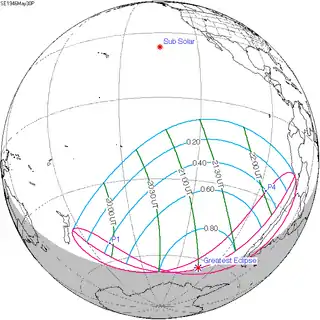 Partial |
122 | November 23, 1946 Partial | |
| 127 | May 20, 1947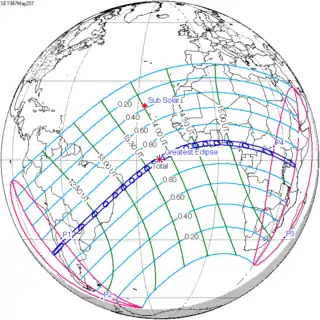 Total |
132 | November 12, 1947 Annular | |
| 137 | May 9, 1948 Annular |
142 | November 1, 1948 Total | |
| 147 | April 28, 1949 Partial |
152 | October 21, 1949 Partial | |
Tritos series
This eclipse is a part of a tritos cycle, repeating at alternating nodes every 135 synodic months (≈ 3986.63 days, or 11 years minus 1 month). Their appearance and longitude are irregular due to a lack of synchronization with the anomalistic month (period of perigee), but groupings of 3 tritos cycles (≈ 33 years minus 3 months) come close (≈ 434.044 anomalistic months), so eclipses are similar in these groupings.
| Series members between 1901 and 2100 | |||
|---|---|---|---|
 March 29, 1903 (Saros 118) |
 February 25, 1914 (Saros 119) |
 January 24, 1925 (Saros 120) | |
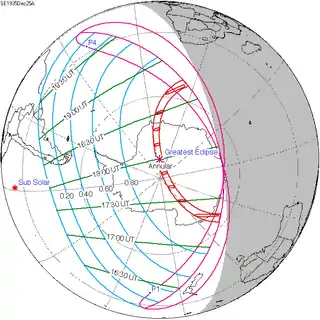 December 25, 1935 (Saros 121) |
 November 23, 1946 (Saros 122) |
 October 23, 1957 (Saros 123) | |
 September 22, 1968 (Saros 124) |
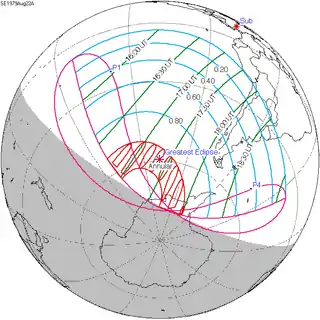 August 22, 1979 (Saros 125) |
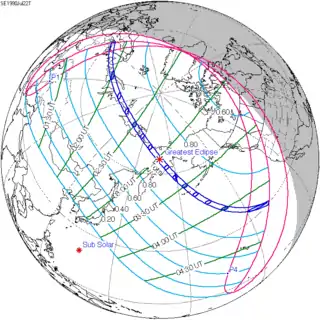 July 22, 1990 (Saros 126) | |
 June 21, 2001 (Saros 127) |
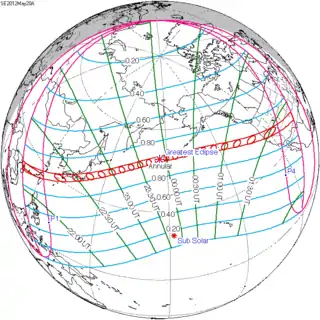 May 20, 2012 (Saros 128) |
 April 20, 2023 (Saros 129) | |
 March 20, 2034 (Saros 130) |
 February 16, 2045 (Saros 131) |
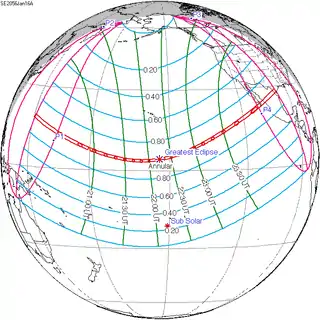 January 16, 2056 (Saros 132) | |
 December 17, 2066 (Saros 133) |
 November 15, 2077 (Saros 134) |
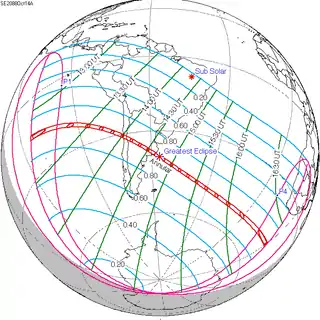 October 14, 2088 (Saros 135) | |
 September 14, 2099 (Saros 136) |
|||
References
- van Gent, R.H. "Solar- and Lunar-Eclipse Predictions from Antiquity to the Present". A Catalogue of Eclipse Cycles. Utrecht University. Retrieved 6 October 2018.
External links
- Earth visibility chart and eclipse statistics Eclipse Predictions by Fred Espenak, NASA/GSFC
.jpg.webp)

